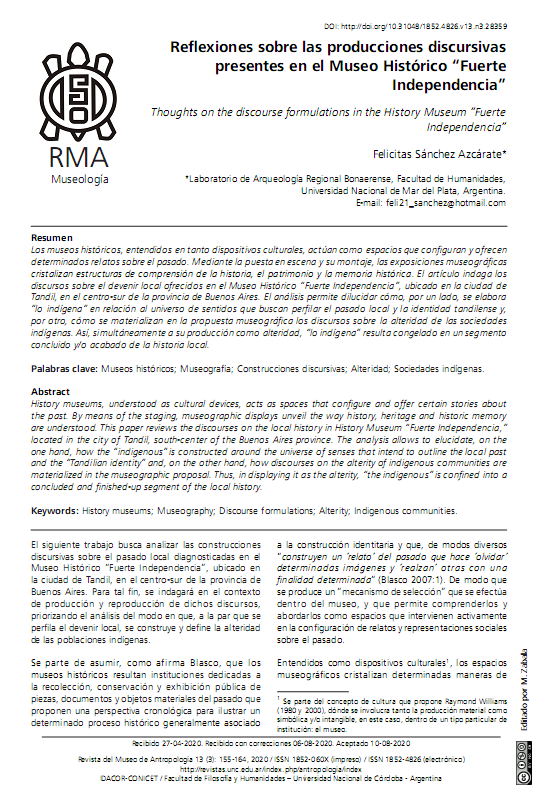Thoughts on the discourse formulations in the History Museum “Fuerte Independencia”
DOI:
https://doi.org/10.31048/1852.4826.v13.n3.28359Keywords:
History museums, Museography, Discourse formulations, Alterity, Indigenous communitiesAbstract
History museums, understood as cultural devices, acts as spaces that configure and offer certain stories about the past. By means of the staging, museographic displays unveil the way history, heritage and historic memory are understood. This paper reviews the discourses on the local history in History Museum “Fuerte Independencia,” located in the city of Tandil, south-center of the Buenos Aires province. The analysis allows to elucidate, on the one hand, how the “indigenous” is constructed around the universe of senses that intend to outline the local past and the “Tandilian identity” and, on the other hand, how discourses on the alterity of indigenous communities are materialized in the museographic proposal. Thus, in displaying it as the alterity, “the indigenous” is confined into a concluded and finished-up segment of the local history.
Downloads
References
Bertoni, L. (2001). “Patriotas, cosmopolitas y nacionalistas. La construcción de la nacionalidad argentina a fines del siglo XIX”. Buenos Aires: Fondo de Cultura Económica.
Blasco, M. E. (2007). Los Museos Históricos en la Argentina entre 1889 y 1943. XI Jornadas Interescuelas/Departamentos de Historia Lugar: Universidad Nacional de Tucumán.
Cattaruzza, A. (2001). Descifrando pasados: debates y representaciones de la historia nacional. En A. CATTARUZZA, (Dir.), Nueva Historia Argentina.
Fernandez Bravo, A (2016). “El museo vacio: acumulación primitiva, patrimonio cultural e identidades colectiva. Argentina y Brasil: 1880-1945”. Ciudad autónoma de Buenos Aires. Editorial EUDEBA.
Lionetti, L. (2007) La misión política de la escuela pública. Formar a los ciudadanos de la república (1870-1916). Buenos Aires: Miño y Dávila Editores.
Morales Moreno, L. G. (2009). “Límites narrativos de los museos de historia”, Alteridades, vol. 19, núm. 37, pp. 43-56, Universidad Autónoma Metropolitana Unidad Iztapalapa Distrito Federal, México.
Nora P. (2008). Pierre Nora en Les Lieux de mémoire. Porlogo de Jose Rilla. Montevideo. Ediciones Trilce.
Novaro, G. (2003). “Indios, aborígenes y pueblos originarios. Sobre el cambio de conceptos y la continuidad de los conceptos escolares”. Revista educación, lenguaje y sociedad. Vol nº1: 199-219.
Pereyra, E. (2006). Museología, historia, patrimonio y sociedad. Vieregg H, Risnicoff de Gorgas M, Schiller R. (eds.), Museología e Historia: un campo de conocimiento, tema 2, XXIX Encuentro Anual del ICOFOM, y XV Encuentro Regional del ICOFOM LAM, Córdoba.
Pérez Calarco, M. I. (2012). Lugones, la hora del cuchillo (entre los dientes). Revista Hispamérica. Año 41, No. 123 (Diciembre 2012), pp. 15-22.
Prieto, A. (1998). “El discurso criollista en la formación de la Argentina moderna”, Sudamericana. Buenos Aires.
Pupio, M. A. (2005). “Coleccionistas de objetos históricos, arqueológicos y de ciencias naturales en museos municipales de la provincia de Buenos Aires en la década de 1950”, História, Ciencias, Saúde-Manguinhos, V. 12, PP. 205-229.
Reca, M. M. (2011). Estudio de público de museos: el aporte teórico-metodológico de la semiótica. Revista do Museu de Arqueología e Etnología, 21: 357-369.
Sorense Goodich, D. (1997) La conferencia pública en la construcción de los mitos nacionales en la argentina del centenario. In: América: Cahiers du CRICCAL, n°18 tome 2. Les Formes brèves de l’expression culturelle en Amérique Latine de 1850 à nos jours : Poésie, Théâtre, Chanson, Chronique, Essai. pp. 559-565.
Uribarren, M. S. (2009). “La Comisión Nacional de Museos y de Monumentos y Lugares históricos de la Argentina entre 1938 y 1946: El patrimonio cultural y la construcción de una idea de Nación”, Cuadernos de Historia, Serie Ec. y Soc., N° 11, CIFFyH-UNC, Córdoba, pp. 213-244.
Vera, J., Soria J. L y G. Seal. (2014). Representaciones del mundo indígena pampeano en ámbitos educativos. En: Mazzanti y Quintana (Eds.) Historias Milenarias Pampeanas. Arqueología de las sierras de Tandilia. Larbo, UNMDP.
Veron, E. (1993). “La semiosis social. Fragmentos de una teoría de la discursividad”. Barcelona: Editoral Gedisa.

Downloads
Published
Issue
Section
License
Copyright (c) 2020 Felicitas Sánchez Azcarate

This work is licensed under a Creative Commons Attribution-NonCommercial-ShareAlike 4.0 International License.
Those authors who have publications with this Journalaccept the following terms:
a. Authors will retain their copyrights and guarantee the journal the right of first publication of their work, which will be simultaneously subject to the Creative Commons Attribution License (Licencia de reconocimiento de Creative Commons) that allows third parties to share the work as long as its author and his first publication in this journal.
b. Authors may adopt other non-exclusive licensing agreements for the distribution of the version of the published work (eg, deposit it in an institutional electronic file or publish it in a monographic volume) provided that the initial publication in this journal is indicated.
c. Authors are allowed and recommended to disseminate their work on the Internet (eg in institutional telematic archives or on their website) before and during the submission process, which can lead to interesting exchanges and increase citations of the published work. (See The Effect of Open Access - El efecto del acceso abierto)











